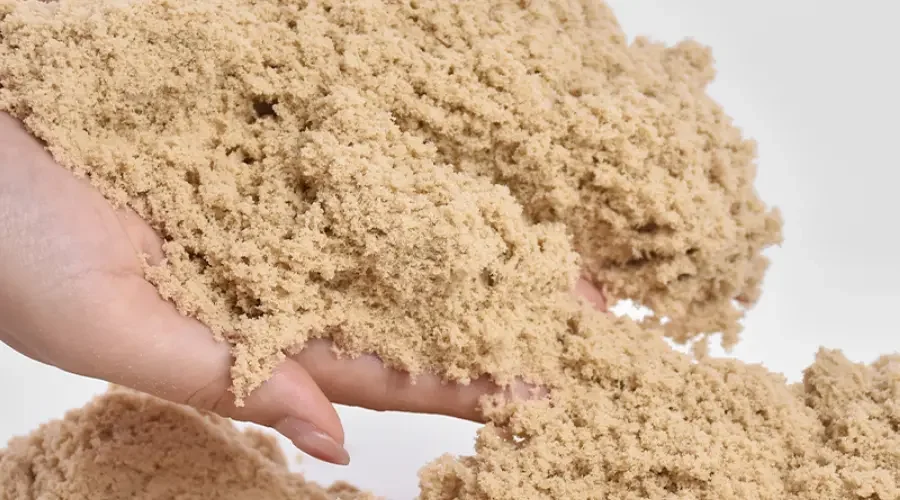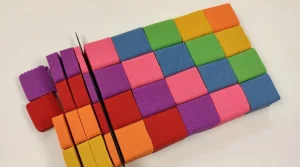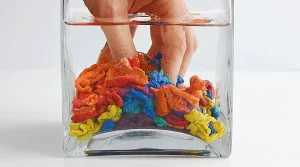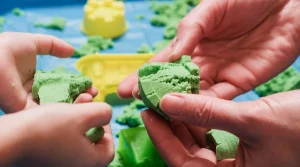
What Is Sensory Sand Made Of? The Science and Benefits
Explore what sensory sand is made of, why children love it, and how its unique materials enhance learning, creativity, and fine motor skills.
#1 Toys Manufacturer in China. WhatsApp: +86 180-0088-4063. Email: [email protected]
#1 Toys Manufacturer in China. WhatsApp: +86 180-0088-4063. Email: [email protected]

Kinetic sand looks like regular sand but feels different. It moves slowly when touched, like it’s alive. But it isn’t magic—it’s science.
Imagine holding sand that sticks only to itself, never to your hands. That’s kinetic sand. It’s dry, yet moldable. Soft, yet keeps its shape.
Kinetic sand is 98% fine sand and 2% polymer—usually polydimethylsiloxane (PDMS), a silicone-based substance. This polymer coats each sand grain.
Because of this coating, the grains attract each other just enough to clump, but not so much that they stick to other surfaces. It’s a balance of cohesion and freedom.
In science terms, it behaves like a non-Newtonian material. That means it changes its flow based on pressure. Push hard, it resists. Touch gently, it flows.
Kinetic sand wasn’t made for toys at first. It was originally developed for therapy and sensory work—especially for kids with autism or sensory issues.
Swedish company Delta of Sweden helped design it as a cleaner, indoor-friendly alternative to wet sand. It grew in popularity around 2010.
Like many science toys, its rise was accidental. Therapists saw its calming effect. Parents noticed their kids stayed focused. It moved from clinics to classrooms.
Regular sand is loose and dry. It falls apart. To mold it, you need water. Even then, it dries quickly and gets messy.
Kinetic sand holds shapes without water. That’s because the polymer gives it a kind of “invisible glue.” But this glue doesn’t make it sticky.
Try this: scoop both kinds into cups. Regular sand spills. Kinetic sand oozes slowly, like thick honey. That’s the polymer at work.
Kinetic sand may feel like something from science fiction, but its behavior can be explained by real-world chemistry and physics. What looks simple—just sand that flows—is actually the result of careful design on a molecular level.
When you squeeze it, it holds. When you let go, it runs. This strange mix of solid and fluid behavior is where the science gets interesting.
Each grain of kinetic sand is coated with a thin layer of silicone oil—a type of polymer. That’s the secret. The polymer sticks to the sand grain, not your fingers.
Because of this coating, the grains cling together, but not too much. That’s what gives it its slow, stretchy motion. It’s engineered stickiness.
The coating doesn’t dry out like water. It stays stable and soft. That’s why kinetic sand feels “wet,” even when it’s dry.
Polymers are long chains of repeating molecules. They’re like cooked spaghetti—wiggly and tangled. Many materials we use every day are made of polymers, like plastic, glue, and even slime.
In kinetic sand, the polymer is silicone-based. This kind of polymer is stretchy, soft, and slippery. It doesn’t mix with water or evaporate. That’s why kinetic sand lasts a long time.
Silicone oil sticks to each grain using weak molecular forces. Think of it like static cling on your clothes—just enough force to hold, but not strong like glue.
The oil forms a flexible film around every tiny particle. When two coated grains touch, they gently attract. This soft bond lets the sand act like a single unit when squeezed but fall apart when left alone.
Scientists call this intermolecular cohesion—a weak but useful kind of stickiness that makes kinetic sand flow like magic.
This material moves because the polymer lets the sand grains slide across each other. But it doesn’t stick to other materials, like your table or skin.
That’s because the polymer likes itself more than it likes other surfaces. It clings to the grains but not to you. It’s like the sand is shy—it only hugs its own kind.
You can test this by pressing kinetic sand onto glass. It lifts off clean, leaving no mess. Regular wet sand would smear. That’s a key difference.
>> How Does Kinetic Sand Work? The Science Behind It
Kinetic sand behaves like a non-Newtonian fluid. That means it doesn’t follow Newton’s laws of viscosity. Push it quickly, and it resists. Let it rest, and it flows.
Surface tension also plays a part. The coating creates tension between grains, keeping the shape stable when molded.
And friction? There’s less of it than in dry sand. The grains glide easily but slow enough to stay in place. That’s why kinetic sand can flow and freeze in shape at the same time.
Kinetic sand is strange stuff. It looks like dry sand, feels a little like wet clay, and moves like thick syrup. But it’s not really any of those.
To understand how it behaves, we need to look at how it reacts under pressure—especially when squeezed, pulled, or dropped. Physics has the answers.
When you press your hand into kinetic sand, it pushes back. That’s called shear resistance. The harder you press, the more the sand resists—but not forever.
After a moment, the grains shift and slide. That’s shear thinning, and it’s tied to viscosity—a measure of how thick or sticky something is.
Kinetic sand’s viscosity isn’t constant. It changes depending on how fast or slow you apply force. That’s why it feels solid when squeezed but slowly flows when left alone.
This is a fun question—even scientists argue about it. Kinetic sand doesn’t fit into the usual categories.
Solids keep their shape. Liquids flow and take the shape of a container. Kinetic sand does both—depending on the situation.
Try this: roll a ball of kinetic sand. It holds. Now leave it for a minute. It flattens slowly, like thick syrup. It’s not just weird—it’s non-Newtonian.
That means its behavior depends on the force applied. It’s a hybrid, a “soft solid,” or more technically, a viscoelastic material.
Slime, oobleck, and kinetic sand are all non-Newtonian, but they behave in different ways.
Oobleck (made from cornstarch and water) turns hard when hit and flows when left still. It’s a shear-thickening fluid.
Slime stretches and flows like a liquid but slowly returns to its shape. It’s more elastic.
Kinetic sand is in between. It doesn’t bounce like slime or crack like oobleck. It molds, flows, and holds—thanks to its grain structure and polymer coating.
These materials show us that not everything fits neat categories. Physics doesn’t always follow rules—it sometimes bends them in fun ways.
Kinetic sand might look simple, but its recipe is far from basic. Behind the soft squish lies a careful mix of materials. Knowing what’s inside helps explain how it works—and why it behaves the way it does.
At its core, kinetic sand is made from 98% regular sand and 2% synthetic polymer, often polydimethylsiloxane (PDMS), a silicone oil.
The sand is pure, cleaned quartz—similar to what’s used in glass or aquarium sand. It’s fine-grain, dry, and uniform.
The silicone oil coats every grain. It creates a soft shell, letting grains stick loosely to each other—but not to your hands or table.
Together, these two ingredients turn dry, gritty sand into something smooth, moldable, and strangely satisfying to play with.
Many parents ask: is kinetic sand safe? The short answer is yes—when made properly.
The silicone oil used (PDMS) is non-toxic and widely used in cosmetics, medical tubing, and even food-safe lubricants (FDA, 21 CFR §177.2600).
Reputable brands test their products to meet safety standards like ASTM D4236, EN71, or CPSIA, which check for things like heavy metals and chemical residues.
Still, safety also depends on use. It’s not meant to be eaten. And younger kids should be supervised, especially if they tend to put things in their mouths.
Kinetic sand is fun—but is it eco-friendly?
The sand part? Yes. Natural quartz is abundant and stable. But the polymer? Not so much.
Silicone polymers do not break down easily in nature. They’re non-biodegradable, though they’re also chemically inert, meaning they don’t leak toxins.
Some newer brands are exploring bio-based coatings, but these are still in early development.
If spilled outdoors, kinetic sand won’t harm soil or plants short-term. But it’s not compostable. Always store and dispose of it responsibly—just like any other soft plastic or rubber material.
Kinetic sand isn’t just fun to squish—it also speaks to your senses. Its texture, weight, and movement trigger responses in the brain and body. This is where science and play meet in a fascinating way.
Our brains are wired to respond to texture. When hands press into kinetic sand, nerves in the skin send signals to the brain’s sensory cortex. The brain then reacts, adjusts pressure, and predicts motion.
This two-way feedback loop is known as sensorimotor integration. It helps us control grip, balance, and hand strength—even in adulthood.
In occupational therapy, materials like kinetic sand are often used for this reason. They combine resistance and flow, making the hands “work” while keeping the brain alert.
Pinching, rolling, and shaping kinetic sand can help build fine motor control, especially in younger children.
This type of play strengthens small muscles in the fingers. It also helps improve coordination between the eyes and hands—a key part of learning to write or tie shoes.
Researchers have noted that multi-sensory play improves spatial awareness and problem-solving (Ayres, 1972). It’s hands-on learning in the purest sense.
Not all science happens in a lab. Take Leo, age 9. When math gets hard, he reaches for kinetic sand.
His fingers move slowly through it. His breath slows down too. This isn’t random. It’s a type of tactile feedback loop.
Soft resistance, smooth texture, and quiet movement can reduce cortisol levels, the body’s stress hormone (Field, 2010).
For some, this mirrors the calm of meditation—without needing to sit still.
The magic of kinetic sand lies in its feel. It’s not wet, but it moves. It’s dry, yet it sticks together.
Touch scientists call this haptic dissonance—a texture that defies expectation. It causes the brain to pay closer attention, leading to a stronger sensory memory.
A 2016 study on sensory-rich materials found that unusual tactile feedback—like what kinetic sand gives—can increase focus and attention in both children and adults (Crane et al., 2016).
So yes, texture matters. It’s not just a feeling—it’s information.
Kinetic sand isn’t just a toy—it’s a material full of questions. What makes it hold shape? Why does it break clean? Can you measure its behavior?
The best way to learn is to test it yourself. Let’s look at how simple tools and curious minds can turn kinetic sand into a lab.
Start with basic questions. Does kinetic sand flow faster when pressed? Can it hold tall shapes? Use rulers, timers, and clear cups to observe.
Try dropping a marble into a sand pile. Watch how the sand shifts. Then record the angle and time it takes to settle. Repeat it.
These hands-on tests teach observation and measurement. They’re simple but surprisingly rich in data.
Try this: fill a small plastic cup with kinetic sand, flip it, and remove the cup. The sand holds the shape—for a while.
Now add a weight on top. How much before it crumbles? You just tested compression.
Next, tilt a tray and let kinetic sand flow down. Measure how far and fast it spreads. You’ve now touched on gravity and friction.
Use cookie cutters, coins, or blocks. See how clean the shapes form. This shows its moldability and structural memory.
Kinetic sand can support STEM learning without needing high-tech tools.
In science, students can test density by comparing kinetic sand to water or dry sand. In math, they can measure volume by packing sand into containers of different shapes.
>> Exploring the Benefits of Kinetic Sand for Sensory Development
In engineering, kids can try to build bridges or arches, then stress-test them. What holds? What collapses? That’s real-world design thinking.
NASA even studies granular flow in space (Morris et al., 2020). So it’s not a stretch to say kinetic sand opens doors to big questions—right from the desk.
Despite its popularity, kinetic sand has sparked some curious myths. People often mistake its unique qualities for something magical.
Many people have asked, “Is kinetic sand alive?” The answer is no—it’s not alive. The sand doesn’t have a mind of its own, but it does behave in a way that can seem almost alive. This is because of the special coating it’s treated with.
The key factor is silicone oil, which makes the sand particles stick together just enough to flow smoothly. When you press on the sand, the oil helps the particles slide past each other, creating a flowing, moving effect. It feels almost like it’s alive, but it’s just the interaction between the sand and oil at work. This is a great example of non-Newtonian behavior, where the material reacts differently depending on the pressure applied.
A common myth about kinetic sand is that it might be edible, or worse, toxic. The good news is that kinetic sand is non-toxic and safe to handle. It’s made primarily from regular sand and silicone oil, both of which are safe in the small amounts used in the product.
However, it’s important to note that kinetic sand is not intended for consumption. Like most sensory toys, it’s designed for play, not for eating. The sand won’t cause harm if it’s accidentally ingested in tiny amounts, but it’s still a good idea to keep it out of your mouth to avoid choking hazards.
One big question many people have is whether kinetic sand can dry out over time. The short answer: no—it doesn’t dry out like regular playdough or clay. The silicone oil in kinetic sand keeps it moist and flexible.
However, if the sand is left in a very dry environment for an extended period, the oil might slowly evaporate. This could cause the sand to lose some of its smooth texture and become less “kinetic.” To prevent this, simply store the sand in a sealed container. As long as the sand is kept in a cool, dry place, it should remain just as fun to play with.
The science behind kinetic sand is truly fascinating. Its unique properties, from its non-Newtonian behavior to its safe, non-toxic composition, make it an exciting and educational material for all ages. Understanding these scientific principles enhances the fun and learning potential of kinetic sand.
Yes, kinetic sand can be reused multiple times. Its unique properties allow it to maintain its shape and texture even after being molded and played with. However, it may pick up dirt or dust over time, so it's best to keep it clean for optimal play.
Kinetic sand is made from natural sand, combined with non-toxic polymers and silicone oils. While it's not biodegradable, it’s safe to use and does not pose a significant environmental threat. Always dispose of it responsibly to minimize waste.
Cleaning kinetic sand is simple. If it gets too dirty, you can rinse it gently with water or use a vacuum to pick up any small debris. Avoid using harsh chemicals, as they may damage its texture or alter its consistency.
Yes, kinetic sand can be stored for long periods if kept in an airtight container. To prevent it from drying out or getting too hard, make sure it’s sealed well and kept in a cool, dry place away from sunlight.
Mixing kinetic sand with other materials, like glitter, small beads, or paint, can add extra sensory elements to the experience. However, be mindful that mixing too much could affect its unique texture and flow. Keep experiments moderate for the best results.
More Related...

Explore what sensory sand is made of, why children love it, and how its unique materials enhance learning, creativity, and fine motor skills.

Discover what makes kinetic sand so special — from its unique texture to the fascinating science behind its magical movement.

Is magic sand safe for kids? Explore safety facts, age guidelines, and expert advice to ensure fun, creative, and secure sensory play.

Kinetic sand toys offer fun and education in one—find out how they support child development, relaxation, and imaginative play.

Our team will answer your inquiries within 48 hours.
Copyright © 2025 GuangDong AKIA Technology Co,. Ltd. All Rights Reserved